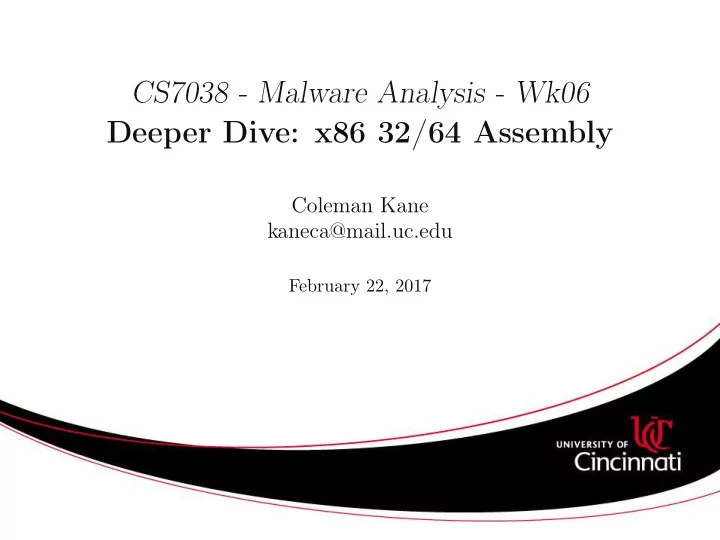

CS7038 - Malware Analysis - Wk06 Deeper Dive: x86 32/64 Assembly Coleman Kane kaneca@mail.uc.edu February 22, 2017 � �
A Deeper Look Previous lecture focused on introducing assembly language and how program can be broken up from source code and translated into assembly language. Our discussion will focus on the Intel/AMD x86 instruction set. Primarily there are 2 versions of it in use today: 32-bit and 64-bit. This instruction set has the following characteristics: Register-memory architecture • Some purpose-specific registers • 8 (32-bit) or 16 (64-bit) direct-access general purpose registers • Segment/Section selectors • Direct / indirect memory access modes • Variable-length instructions • Internal flags, instruction pointer, and machine registers • � �
Assembly Language Source Variations All instructions are compact binary structures. Since Assembly Language is basically a textual representation of binary encoded instructions. One thing you will encounter is that the Assembly source code is just a textual representation of the binary data. Due to this, there are differing approaches to translating it into human-readable source. The following two methods are predominantly used: AT&T, UNIX, or GNU syntax. In general: OP SRC DEST , read OP • SRC -> DEST . Frequently registers are prefixed with % symbol. Example: “ movl %rax,%rbx ” puts a copy of what’s in RAX into RBX Intel or Microsoft syntax. In general: OP DEST SRC , read OP DEST • <- SRC . Frequently op names don’t include data width (l, b, w, q) specifiers. Example: “ mov rbx,rax ” same as above � �
Instruction Lengths x86 instructions are a sequence of bytes describing a unique atomic CPU operation. It is described as a variable-width instruction set, meaning that there is no fixed size for all instructions, but rather the number of bytes that comprises an instruction is based upon the instruction and its parameters. Examples: jmp %rax : Jump to address provided in %rax • 2 bytes movq $0x0000000011111111,%rbx • Copy numeric value 0x011111111 into %rbx , 10 bytes addl $0x12,-0x8(%ebp) : • Add the 32-bit value 0x00000012 to the 32-bit value stored in the memory location specified by performing the pointer calculation %ebp - 0x08 , 4 bytes . nop : Do nothing, 1 byte • � �
Generalized Instruction Formats Instructions can be anywhere from 1 byte to ∼ 15 bytes depending upon their purpose. As a general rule, x86 attempts to reserve the shorter instructions for the more frequent ones, and relegates longer instructions to represent less common operations. A common layout is below: Operation ModR/M SIB [Displacement] [Immediate] [...] In the above: Operation is typically 1 or 2 bytes, but can be 4 bytes to reflect a • “modified” version of an operation using a 1-2 byte reserved prefix value ModR/M ( when required ) is a single byte that informs the CPU as to • how to interpret operands (memory, register, immediate) as well as addressing modes SIB ( when required ) for a scaled addressing operation, what mem • register to use and what multiplier to use Displacement, Immediate, ... operand values that are provided - • � � lengths may vary
CPU Registers Local memory directly addressable by (most) instructions in the CPU. In the 64bit x86 architecture, there are 16 registers that can be addressed using the names R01 - R15 . The architecture also assigns some of these registers to “special purposes” in many instructions, an oddity that isn’t shared by all CPU architectures. Accumulator (freq. result storage) R0 RAX Counter (freq. used as i in iterations/loops R1 RCX Data (freq. additional argument in operation) R2 RDX Base (freq. used as a base address/counter) R3 RBX Stack pointer (used to keep track of top of CPU stack) R4 RSP Base pointer (used to keep track of base of CPU stack) R5 RBP Source index (keeps track of indexes of source arrays) R6 RSI Destination index (keeps track of indexes of destination arrays) R7 RDI There are R8 - R15 that are 8 more general registers with no other specialized purpose. In most operations that accept a register, any R0 - R15 may be used. � �
Memory Addressing Instructions can have varying addressing modes that represent common programming patterns where it comes to addressing memory. The below addressing modes relate directly to various methods you may use in array & matrix operations in higher level languages, as well as those containing complex data structures as elements. Register addressing: movq %rax,%rbx • Immediate addressing: movq $0x0a,%rbx • Direct memory: movq 0x1000,%rax • Register indirect mem.: movq (%rbx),%rax • Reg-indirect + offset mem.: movq 0x8(%rbx),%rax • Reg-indirect*C + offset mem.: movq 0x8(,%rbx,4),%rax • Base + Reg-indirect*C + offset mem.: • movq 0x8(%rdx,%rbx,4),%rax � �
Recommend
More recommend